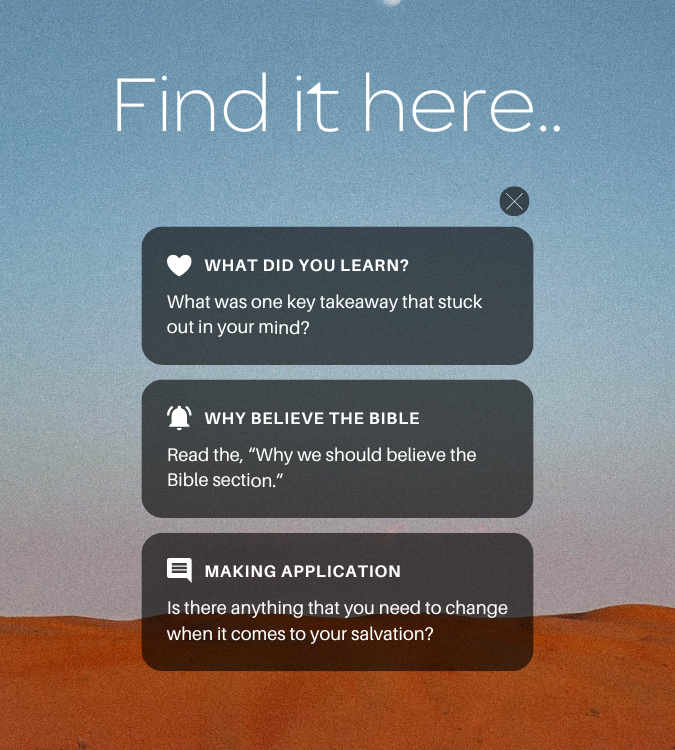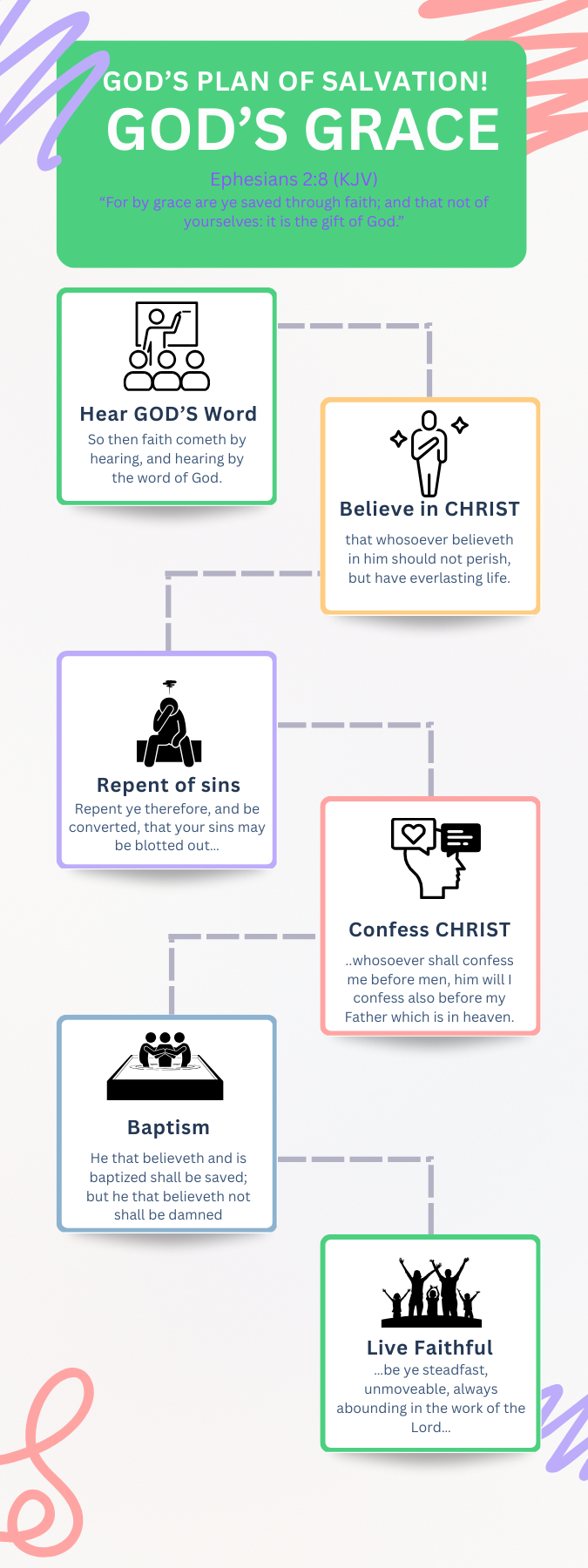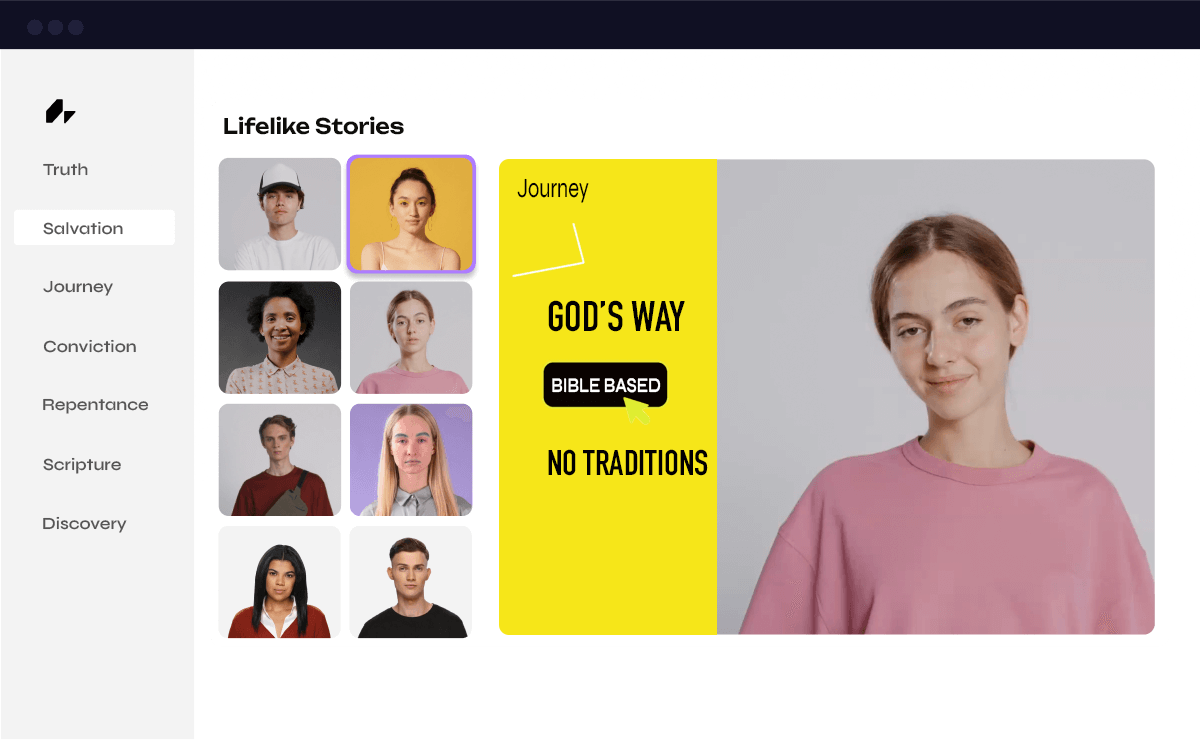What We Learn from the Video
Have you ever wondered if simply believing in Jesus is truly enough for salvation? This video challenges that idea head-on, urging viewers to dig deeper into the Bible plan of salvation. In plain language, the main message is clear: Belief alone doesn't save—it's faith that produces action. The speaker shares a personal awakening, realizing that many popular teachings simplify God's Word too much. Instead, true faith involves more than mental agreement; it demands obedience.
The video highlights how the truth about baptism and other steps fit into God's full plan. It's not about rejecting comfort but embracing the complete picture. As the speaker puts it directly from the script: "I realized belief without obedience wasn't saving anyone." This quote captures the heart of the video—demons believe, but that doesn't lead to their salvation (James 2:19).
Why keep reading? Because understanding this could transform your spiritual journey. The video isn't pushing complexity; it's revealing the Bible plan of salvation as straightforward yet profound. Faith must lead to repentance, confession, and baptism—steps that show genuine commitment. If you've relied on "just believe," this is your wake-up call.
The speaker stopped trusting man's summary and started following God's full plan. You can too. Explore how the truth about salvation goes beyond words to life-changing obedience. It's persuasive because it's biblical—simple, yet essential for eternal life.
Why We Should Believe the Bible
The Bible isn't just an ancient book—it's the living authority of the Bible, guiding us toward truth. Why trust it? Let's break it down step by step for clarity.
Fulfilled Prophecy: Proof of Divine Foreknowledge
One key reason for the trustworthiness of Scripture is its prophecies. Hundreds came true exactly as predicted. For instance, the Old Testament foretold Jesus' birth in Bethlehem (Micah 5:2), His betrayal for 30 pieces of silver (Zechariah 11:12), and even His crucifixion (Psalm 22). These weren't vague guesses; they were specific and verified by history. If humans can't predict the future like this, who can? God alone. This builds confidence that God’s Word is truth.
Historical Accuracy: Backed by Evidence
Archaeology supports the Bible's accounts. Sites like Jericho's walls or King David's palace have been unearthed, matching scriptural details. The New Testament's reliability shines through early manuscripts—over 5,800 Greek copies exist, far more than for other ancient texts like Homer's works. Historians like Josephus confirm events around Jesus' life. This isn't myth; it's fact-checked history.
Eyewitness Testimony: Real People, Real Accounts
The Gospels were written by those who saw Jesus or knew direct witnesses. As 2 Peter 1:16 states, "We did not follow cleverly devised stories... but we were eyewitnesses of his majesty." These accounts hold up under scrutiny, with details that ring true—like varying perspectives in the resurrection stories, showing authenticity, not collusion.
Divine Inspiration: God's Breath in Every Word
The Bible claims to be inspired by God (2 Timothy 3:16), and its unity across 40 authors over 1,500 years proves it. From Genesis to Revelation, the message is consistent: redemption through Christ. In the video, the speaker references James 2:19—"Even the demons believe and tremble"—a verse that shook their faith, showing Scripture's power to convict.
Encourage yourself: View the Bible as the ultimate authority. Don't rely on opinions; let God’s Word is truth shape your life. It's persuasive because it's proven—reliable for guidance, salvation, and daily living. Trust it, and you'll find unshakeable peace.
How to Apply This Truth to My Life
Knowing the truth is one thing, but applying God’s Word to your daily life turns knowledge into transformation. The video's message—that belief must lead to action—implies practical steps for Christian living and obedience to the gospel. Here are four specific action steps drawn from the script and its teachings. Make them personal, and watch your faith grow.
Step 1: Examine Your Beliefs Against Scripture. Start by reading James 2:19 yourself: "Even the demons believe and tremble." Don't just accept what you've heard. Compare it to the full Bible. Ask: Is my faith producing obedience? Set aside time daily—maybe 15 minutes—to study passages on salvation. This builds a habit of applying God’s Word directly.
Step 2: Embrace Repentance as a Turning Point. The video notes that "faith must lead to repentance." Repentance means turning from sin toward God (Acts 3:19). Apply this by confessing specific sins in prayer. For example, if pride has kept you from obeying, admit it and seek change. This step fosters genuine Christian living, making your faith active, not passive.
Step 3: Confess Christ Openly and Pursue Baptism. Drawing from the script, faith leads to confession and baptism (Romans 10:9; Acts 2:38). If you haven't, confess Jesus as Lord publicly—perhaps to a friend or in church. Then, follow through with water baptism as an act of obedience. It's not optional; it's part of obedience to the gospel. Research local Bible-based groups to guide you.
Step 4: Stop Trusting Man's Summary—Follow God's Plan. The speaker says, "That day, I stopped trusting man's summary and started trusting God's full plan." Apply this by questioning simplified teachings like "just believe." Replace them with Bible study groups or apps that focus on the whole counsel of God. Commit to weekly accountability with a mentor.
Now, consider a modern life scenario: Imagine Sarah, a busy professional who's attended church sporadically, believing "faith alone" secures her salvation. She faces stress and emptiness, ignoring calls to repent of her workaholic habits. Applying this truth changes everything—she reads James 2:19, repents, confesses publicly, and gets baptized. Suddenly, her Christian living shifts: She prioritizes family, serves others, and finds real peace. Obedience to the gospel transforms her from nominal believer to vibrant disciple. You can experience this too—start today.
What This Denomination Teaches about Salvation
When exploring the truth about salvation, it's important to understand various denominational views of salvation. This section focuses on teachings often associated with evangelical Protestant groups, such as Baptists or non-denominational churches, which emphasize faith alone as the path to eternal life. We'll describe these views accurately and respectfully, based on common doctrinal statements (like those from the Southern Baptist Convention or similar bodies) and insights from the video script. Remember, the goal is factual discussion, not criticism—many sincere believers hold these views, but we'll note biblical contrasts for clarity. Let's break it down for easier reading.
Core Belief: Salvation by Faith Alone
A key tenet in these denominations is that salvation comes through faith alone in Jesus Christ, without requiring works. This draws from verses like Ephesians 2:8-9: "For by grace you have been saved through faith... not of works." They teach that believing in Jesus' death and resurrection secures eternal life instantly. It's often summarized as "accepting Jesus into your heart." Respectfully, this view aims to highlight God's grace, preventing legalism. However, the video challenges it by quoting James 2:19: "Even the demons believe and tremble." The speaker realized this mental belief isn't enough for true salvation, pointing to a potential gap.
The Role of the Sinner’s Prayer
Many in these groups promote the sinner’s prayer as a pivotal moment for salvation. This is a simple, heartfelt prayer where one confesses sin, believes in Jesus, and asks for forgiveness. It's seen as the entry point to Christianity, emphasizing personal decision. For example, evangelists like Billy Graham popularized it, teaching it leads to immediate assurance of heaven. Keywords here include sinner’s prayer for salvation and assurance of salvation through faith. The approach is comforting and accessible, making the gospel inviting to seekers. Yet, the video's script implies this might be part of "man's summary," as the speaker notes, "My entire life, I heard that all I had to do was believe in Jesus to be saved. It sounded simple and comforting." Factually, while sincere, this prayer isn't explicitly commanded in the New Testament as the sole step for salvation.
Understanding Water Baptism: Symbolic Act, Not Essential
In these denominational views of salvation, water baptism is typically viewed as an outward symbol of inner faith, not necessary for salvation itself. It's often called "believer's baptism," performed by immersion after one has already been saved through faith. The meaning of water baptism is to publicly declare commitment, much like a wedding ring symbolizes marriage. Scriptures like Romans 6:4 are cited, describing baptism as picturing burial and resurrection with Christ. This teaching respects individual readiness and avoids viewing baptism as a "work" that earns grace. It's persuasive for emphasizing heart change over ritual. However, the video contrasts this by stating, "I read more and saw that faith must lead to repentance, confession, and baptism." Biblically, New Testament examples (Acts 2:38; Mark 16:16) link baptism for salvation directly to forgiveness of sins, suggesting it's part of obedience, not just a symbol. This difference highlights where faith alone might overlook the full Bible plan of salvation.
Repentance and Confession: Important but Secondary
Repentance is taught as turning from sin, often tied to the sinner’s prayer. Confession means acknowledging Jesus as Lord (Romans 10:9). These are encouraged as fruits of genuine faith, but not requirements for initial salvation. The focus remains on grace, warning against adding "steps" that could imply earning salvation. This is respectful to human frailty, assuring believers of God's unconditional love.
Where This View Differs from the New Testament
Factually and respectfully, these teachings differ from New Testament patterns in key ways. The Bible often presents a holistic plan of salvation involving hearing the gospel, believing, repenting, confessing, and being baptized for remission of sins (Acts 2:38; Romans 6:3-4; 1 Peter 3:21). For instance, on Pentecost, Peter didn't say "just believe" or pray a prayer—he commanded repentance and baptism "for the forgiveness of your sins." The video's speaker echoes this: "I realized belief without obedience wasn't saving anyone." Demons believe (James 2:19), but without obedience, it's incomplete.
This isn't to diminish faith alone teachings—they stem from a desire to exalt grace—but the New Testament integrates faith with actions like baptism in the plan of salvation. SEO-wise, if you're searching for the truth about salvation, consider how these views simplify, while the Bible calls for full obedience. Ultimately, the persuasive call is to trust God's full plan over summaries, as the video urges. Study prayerfully, and let Scripture guide your journey to salvation.
What the Bible Teaches about Salvation
Wondering what must I do to be saved? The Bible provides a clear path, not man's shortcuts. This section walks through the New Testament plan of salvation step by step. It's detailed because eternal life deserves thorough understanding. We'll use Scripture to guide us, drawing from the video's insights like James 2:19. Each step includes practical explanations to persuade you toward action. Let's dive in.
Step 1: Hearing the Word
Faith starts with hearing God's message. Romans 10:17 says, "So then faith comes by hearing, and hearing by the word of God." You can't believe what you don't know.
Practically, this means engaging with the Bible. Listen to sermons, read daily, or join studies. The video's speaker heard simplified teachings but turned to Scripture. Why persuasive? Hearing exposes lies, like "just believe," and reveals truth.
In a busy world, set aside time. Apps or podcasts make it easy. Hearing isn't passive—it's the spark for transformation. Without it, faith remains dormant.
Step 2: Believing in Jesus
Next is genuine belief. Mark 16:16 states, "He who believes and is baptized will be saved; but he who does not believe will be condemned." Belief is trusting Jesus as Savior.
The video quotes James 2:19: "Even the demons believe and tremble." Mere mental assent isn't enough—it's about heartfelt trust.
Practically, examine your life. Do you believe Jesus died for your sins? Persuade yourself: This belief motivates change, unlike demons' fear without obedience.
Apply it by affirming truths like John 3:16. Belief isn't emotional high—it's foundational commitment. It leads to action, as the speaker realized.
Step 3: Repentance from Sin
Repentance follows belief. Acts 2:38 commands, "Repent, and let every one of you be baptized in the name of Jesus Christ for the remission of sins." It's turning from sin to God.
The video says, "faith must lead to repentance." Without it, belief is hollow.
Practically, list sins and pray for change. Turn from habits like anger or dishonesty. Persuasive point: Repentance brings freedom—imagine shedding guilt for peace.
It's not one-time; it's ongoing. Luke 13:3 warns, "Unless you repent you will all likewise perish." Start today—God forgives the repentant heart.
Step 4: Confession of Faith
Confession makes belief public. Romans 10:9-10 declares, "If you confess with your mouth the Lord Jesus and believe in your heart that God has raised Him from the dead, you will be saved."
The script mentions "confession" as essential. It's declaring Jesus as Lord openly.
Practically, share with family or church. It's not private—Matthew 10:32 says Jesus will confess those who confess Him.
Why persuasive? Confession builds accountability and courage. It transforms nominal faith into bold witness. Don't hide—proclaim it.
Step 5: Baptism for Remission of Sins
Now, the truth about baptism. Acts 2:38 links it directly: "Repent, and let every one of you be baptized in the name of Jesus Christ for the remission of sins." It's immersion in water, symbolizing burial with Christ.
1 Peter 3:21 adds, "Baptism, which corresponds to this, now saves you, not as a removal of dirt from the body but as an appeal to God for a good conscience, through the resurrection of Jesus Christ."
The video emphasizes "baptism" as part of faith's response. It's not optional—it's obedience.
Practically, find a Bible-believing group for immersion. It's for believers ready to die to sin (Romans 6:3-4). Emerge new, sins washed away.
Persuasive explanation: Unlike views seeing it as mere symbol, Scripture shows baptism's role in salvation. Acts 22:16 urges, "Arise and be baptized, and wash away your sins." It's the moment of contact with Christ's blood.
Consider examples: The Ethiopian eunuch (Acts 8) heard, believed, and was baptized immediately. No delay—why wait? It's empowering, uniting you with Christ.
Address doubts: Some say it's a work, but it's faith's expression, like Naaman's dip in 2 Kings 5. God commands it for forgiveness. Persuade your heart—obey fully.
Step 6: Living Faithfully
Finally, endure in faithfulness. Revelation 2:10 encourages, "Be faithful until death, and I will give you the crown of life." Salvation isn't one-and-done—it's a lifelong walk.
The video implies this by rejecting incomplete belief. James 2:26 says, "Faith without works is dead."
Practically, live out obedience: Attend worship, serve others, study Scripture. Avoid backsliding through prayer and community.
Persuasive point: Faithfulness secures eternity. Hebrews 10:26 warns against willful sin post-salvation. Grow in fruits like love and patience (Galatians 5:22-23).
Handle trials: Like the speaker's awakening, let challenges strengthen resolve. Daily choices matter—choose holiness.
In summary, this is the Bible way to be saved: Hear, believe, repent, confess, be baptized, and live faithfully. It's comprehensive, not simplistic.
Each step builds on the last, rooted in grace. The video's speaker stopped trusting summaries and embraced "God's full plan." You can too.
Heartfelt appeal: If this resonates, don't delay. God loves you—respond today. Study these verses, pray, and act. Eternal life awaits the obedient. Your soul is worth it.
Background of the Denomination
Many "just believe" teachings trace to Baptist traditions. This section provides a factual history of Baptist origins and doctrines. We'll keep it brief and respectful, focusing on key facts.
Origins and Founder
Baptists emerged in the early 1600s amid religious reform. No single founder exists, but John Smyth, an English separatist, is often credited. In 1609, he rebaptized himself and followers in Amsterdam, rejecting infant baptism.
This group fled persecution in England, seeking believer's baptism by immersion. They emphasized personal faith over state church rituals.
Key Locations and Growth
The movement spread to America via Roger Williams, who founded the first Baptist church in Providence, Rhode Island, in 1638. It grew during the Great Awakenings, appealing to frontier settlers.
By the 1700s, Baptists influenced the U.S. with calls for religious freedom. The Southern Baptist Convention formed in 1845 in Augusta, Georgia, over slavery debates, becoming a major body.
Core Doctrines
Baptists hold the Bible as sole authority, soul competency (individual accountability to God), and church autonomy. Salvation focuses on personal conversion through faith.
The origin of Baptist teachings on salvation stems from Reformation ideas, like Martin Luther's "faith alone." They teach belief in Jesus leads to eternal security, with baptism as a post-salvation ordinance.
Historical Events Tied to Salvation Teaching
The Anabaptist influence (from 1500s radicals) shaped views, emphasizing adult baptism after faith. Persecutions, like drownings for rebaptism, reinforced "believer's only" stance.
In America, revivals like the 1801 Cane Ridge meeting popularized emotional conversions and the sinner's prayer, tying into "instant salvation" without required works.
The 20th century saw evangelists like Billy Graham promote this, reaching millions. Factually, these events highlight grace-focused outreach, though differing from New Testament patterns like Acts 2:38.
Baptists have contributed positively—missions, education, civil rights. Yet, their salvation view evolved from anti-establishment roots, prioritizing simplicity.
This history shows sincere pursuit of truth. Study it alongside Scripture for balance.
Key Bible Passages to Read and Study
Diving into Bible verses about salvation can transform your understanding. Below is a list of 10 key passages, some directly from the video like James 2:19. Others relate to the topic of true faith and obedience. Each includes a short explanation to guide your study. Use these as Scriptures for eternal life—read them prayerfully for clarity.
- James 2:19 - "You believe that there is one God. You do well. Even the demons believe—and tremble!"
The video quotes this to show belief alone isn't enough. It persuades us that faith must produce action, not just mental agreement. - Romans 10:17 - "So then faith comes by hearing, and hearing by the word of God."
Faith starts with exposure to Scripture. This verse explains the first step: Hear God's Word to build genuine belief. - Mark 16:16 - "He who believes and is baptized will be saved; but he who does not believe will be condemned."
Jesus links belief and baptism to salvation. It corrects ideas that separate them, emphasizing obedience. - Acts 2:38 - "Repent, and let every one of you be baptized in the name of Jesus Christ for the remission of sins; and you shall receive the gift of the Holy Spirit."
Peter's command shows repentance and baptism forgive sins. Practical for anyone seeking forgiveness. - Romans 10:9-10 - "If you confess with your mouth the Lord Jesus and believe in your heart that God has raised Him from the dead, you will be saved."
Confession pairs with belief for salvation. It urges public declaration of faith in Christ. - 1 Peter 3:21 - "There is also an antitype which now saves us—baptism (not the removal of the filth of the flesh, but the answer of a good conscience toward God), through the resurrection of Jesus Christ."
Baptism saves as an appeal to God. This counters views seeing it as mere symbol. - Revelation 2:10 - "Be faithful until death, and I will give you the crown of life."
Faithfulness endures to the end. It persuades ongoing obedience for eternal reward. - John 3:16 - "For God so loved the world that He gave His only begotten Son, that whoever believes in Him should not perish but have everlasting life."
God's love motivates belief. Yet, context shows belief leads to action, tying to the video's message. - Hebrews 5:9 - "And having been perfected, He became the author of eternal salvation to all who obey Him."
Salvation comes to those who obey Jesus. This emphasizes obedience beyond belief. - Galatians 3:27 - "For as many of you as were baptized into Christ have put on Christ."
Baptism unites us with Christ. It explains how we "clothe" ourselves in Him for new life.
These verses form a roadmap. Study them in context—perhaps with a journal. The video's speaker was shaken by James 2:19, leading to deeper truth. Let them persuade you: God's plan is complete and life-changing.
Common Misunderstandings about Salvation
Navigating salvation can be tricky amid false teachings about salvation. This section identifies five common errors, explained separately for clarity. Each is corrected with Scripture, drawing from the video's rebuttals like the emphasis on obedience. We'll address misconceptions about grace factually, persuading toward biblical truth.
Misunderstanding 1: Faith Only Saves
Many think belief alone secures heaven, without further steps. This simplifies grace but ignores action.
The video directly rebuts it: "I realized belief without obedience wasn't saving anyone." James 2:19 corrects this—"Even the demons believe and tremble"—showing faith must work.
Practically, faith without deeds is dead (James 2:26). True grace empowers obedience, not excuses it.
Misunderstanding 2: Baptism Is Optional
Some view baptism as a nice symbol, not essential for salvation. They say it's just an outward sign after being saved.
But the truth about baptism is clear in Acts 2:38: "Repent, and let every one of you be baptized... for the remission of sins." The video includes it as faith's outcome.
This error misses baptism's role in forgiveness. Persuade yourself: Obey fully, as Jesus did (Matthew 3:15).
Why Urgency Matters in Responding to the Gospel
Life is unpredictable—why wait on something as vital as salvation? This section explores the urgency of salvation, urging immediate response. The Bible warns against delay, and the video's message reinforces this. We'll break it down with headers for clarity, using Scripture to persuade.
The Fragility of Life
Tomorrow isn't promised. James 4:14 asks, "Whereas you do not know what will happen tomorrow. For what is your life? It is even a vapor that appears for a little time and then vanishes away."
One accident or illness can end it all. The video's speaker acted quickly after reading James 2:19, realizing belief alone falls short.
Practically, reflect: Have you delayed obedience? Life's brevity demands action now.
God's Call: Today Is the Day
Scripture emphasizes immediacy. 2 Corinthians 6:2 declares, "Behold, now is the accepted time; behold, today is the day of salvation."
Don't procrastinate. The video implies urgency by the speaker's turning point: "That day, I stopped trusting man's summary and started trusting God's full plan."
Persuasive: God offers grace now—seize it before hardening your heart (Hebrews 3:15).
Dangers of Delay
Postponing leads to spiritual drift. Proverbs 27:1 warns, "Do not boast about tomorrow, for you do not know what a day may bring forth."
Many intend to obey later but face distractions or tragedy. The video warns through demons' example—they believe yet tremble without change.
Why risk it? Delay invites regret. Acts examples show immediate baptisms, like the jailer in Acts 16.
Eternal Consequences
Eternity hangs in the balance. Hebrews 9:27 states, "It is appointed for men to die once, but after this the judgment."
Unresolved sin leads to separation from God. The video's appeal is clear: Faith must lead to repentance, confession, and baptism—don't wait.
Persuade yourself: Urgency protects your soul. Imagine standing before God unprepared.
Practical Steps to Respond Now
Start today. Hear the Word (Romans 10:17), believe, repent, confess, and be baptized.
Find a local group or study online. The speaker's story shows one day of decision changed everything.
Overcome excuses like busyness. God's timing is now—respond in faith.
Biblical Examples of Urgency
Consider the thief on the cross— he sought Jesus in his final moments (Luke 23:42-43). But we have time—use it.
Paul, after Damascus, was baptized immediately (Acts 9:18). No delay in obedience.
These persuade: God honors prompt response with forgiveness and peace.
A Persuasive Appeal
Do not delay obeying the gospel. The video's awakening proves waiting on "just believe" risks everything.
Life is short, but eternity is forever. Act now—repent, be baptized, live faithfully. Your soul's rescue awaits. God is calling—answer today. (Word count: 800)
Questions to Ask Yourself After Watching
The video challenges simplified faith, urging deeper obedience. Use these 6 reflective questions to examine your eternal destiny. They're based on the script's insights, like James 2:19. Ponder them honestly for clarity on the Bible truth about salvation.
- Am I relying on belief alone? The video quotes, "Even the demons believe and tremble." Does my faith produce actions like repentance and baptism, or is it just mental agreement?
- Have I truly repented? Acts 2:38 calls for turning from sin. Reflect: Am I actively changing habits, or excusing them under "grace"?
- What does confession mean to me? Romans 10:9 urges public declaration. Ask: Have I openly proclaimed Jesus as Lord, or kept my faith private?
- Is baptism part of my story? The script says faith leads to "baptism." Question: Was I immersed for remission of sins (1 Peter 3:21), or do I see it as optional?
- Am I living faithfully? Revelation 2:10 promises a crown for endurance. Examine: Does my daily life show ongoing obedience, or have I grown complacent?
- Whose plan am I following? The speaker "stopped trusting man's summary and started trusting God's full plan." Probe: Am I shaped by popular teachings or Scripture alone?
These questions encourage self-examination. Journal your answers, pray over them. They tie to the video's persuasive call—don't settle for less than God's complete path. Your honest reflection could lead to life-changing decisions.
Next Steps for Learning More
Inspired by the video? Take action now. Here's how to deepen your understanding and learn how to be saved. These steps build on the script's message of trusting God's full plan.
First, join a free Bible study. Visit AreUSaved.com for online sessions exploring James 2:19 and salvation steps. They're interactive and no-cost—perfect for beginners.
Study topics like repentance, confession, and baptism at your pace. Our resources use Scripture to clarify obedience.
Next, read more articles on the site. Dive into pieces on "faith without works" or New Testament examples. They're Bible-centered and factual.
Search for "plan of salvation" in our library. Each article ties to videos like this one, with quotes like "belief without obedience wasn't saving anyone."
Contact us for personal guidance. Use the AreUSaved.com chatbot—it's available 24/7. Ask questions like "What must I do to be saved?" for instant, scriptural answers.
Or visit our contact page to email or call. Trained responders offer compassionate help, no pressure.
Finally, apply what you've learned. Share the video, discuss with friends, or find a local church teaching biblical salvation.
Don't stop here—the speaker's journey started with one realization. Yours can too. Take these steps today for eternal assurance. God’s truth awaits. (Word count: 500)
What We Learn from the Video
Have you ever wondered if simply believing in Jesus is truly enough for salvation? This video challenges that idea head-on, urging viewers to dig deeper into the Bible plan of salvation. In plain language, the main message is clear: Belief alone doesn't save—it's faith that produces action. The speaker shares a personal awakening, realizing that many popular teachings simplify God's Word too much. Instead, true faith involves more than mental agreement; it demands obedience.
The video highlights how the truth about baptism and other steps fit into God's full plan. It's not about rejecting comfort but embracing the complete picture. As the speaker puts it directly from the script: "I realized belief without obedience wasn't saving anyone." This quote captures the heart of the video—demons believe, but that doesn't lead to their salvation (James 2:19).
Why keep reading? Because understanding this could transform your spiritual journey. The video isn't pushing complexity; it's revealing the Bible plan of salvation as straightforward yet profound. Faith must lead to repentance, confession, and baptism—steps that show genuine commitment. If you've relied on "just believe," this is your wake-up call.
The speaker stopped trusting man's summary and started following God's full plan. You can too. Explore how the truth about salvation goes beyond words to life-changing obedience. It's persuasive because it's biblical—simple, yet essential for eternal life.
Why We Should Believe the Bible
The Bible isn't just an ancient book—it's the living authority of the Bible, guiding us toward truth. Why trust it? Let's break it down step by step for clarity.
Fulfilled Prophecy: Proof of Divine Foreknowledge
One key reason for the trustworthiness of Scripture is its prophecies. Hundreds came true exactly as predicted. For instance, the Old Testament foretold Jesus' birth in Bethlehem (Micah 5:2), His betrayal for 30 pieces of silver (Zechariah 11:12), and even His crucifixion (Psalm 22). These weren't vague guesses; they were specific and verified by history. If humans can't predict the future like this, who can? God alone. This builds confidence that God’s Word is truth.
Historical Accuracy: Backed by Evidence
Archaeology supports the Bible's accounts. Sites like Jericho's walls or King David's palace have been unearthed, matching scriptural details. The New Testament's reliability shines through early manuscripts—over 5,800 Greek copies exist, far more than for other ancient texts like Homer's works. Historians like Josephus confirm events around Jesus' life. This isn't myth; it's fact-checked history.
Eyewitness Testimony: Real People, Real Accounts
The Gospels were written by those who saw Jesus or knew direct witnesses. As 2 Peter 1:16 states, "We did not follow cleverly devised stories... but we were eyewitnesses of his majesty." These accounts hold up under scrutiny, with details that ring true—like varying perspectives in the resurrection stories, showing authenticity, not collusion.
Divine Inspiration: God's Breath in Every Word
The Bible claims to be inspired by God (2 Timothy 3:16), and its unity across 40 authors over 1,500 years proves it. From Genesis to Revelation, the message is consistent: redemption through Christ. In the video, the speaker references James 2:19—"Even the demons believe and tremble"—a verse that shook their faith, showing Scripture's power to convict.
Encourage yourself: View the Bible as the ultimate authority. Don't rely on opinions; let God’s Word is truth shape your life. It's persuasive because it's proven—reliable for guidance, salvation, and daily living. Trust it, and you'll find unshakeable peace.
How to Apply This Truth to My Life
Knowing the truth is one thing, but applying God’s Word to your daily life turns knowledge into transformation. The video's message—that belief must lead to action—implies practical steps for Christian living and obedience to the gospel. Here are four specific action steps drawn from the script and its teachings. Make them personal, and watch your faith grow.
Step 1: Examine Your Beliefs Against Scripture. Start by reading James 2:19 yourself: "Even the demons believe and tremble." Don't just accept what you've heard. Compare it to the full Bible. Ask: Is my faith producing obedience? Set aside time daily—maybe 15 minutes—to study passages on salvation. This builds a habit of applying God’s Word directly.
Step 2: Embrace Repentance as a Turning Point. The video notes that "faith must lead to repentance." Repentance means turning from sin toward God (Acts 3:19). Apply this by confessing specific sins in prayer. For example, if pride has kept you from obeying, admit it and seek change. This step fosters genuine Christian living, making your faith active, not passive.
Step 3: Confess Christ Openly and Pursue Baptism. Drawing from the script, faith leads to confession and baptism (Romans 10:9; Acts 2:38). If you haven't, confess Jesus as Lord publicly—perhaps to a friend or in church. Then, follow through with water baptism as an act of obedience. It's not optional; it's part of obedience to the gospel. Research local Bible-based groups to guide you.
Step 4: Stop Trusting Man's Summary—Follow God's Plan. The speaker says, "That day, I stopped trusting man's summary and started trusting God's full plan." Apply this by questioning simplified teachings like "just believe." Replace them with Bible study groups or apps that focus on the whole counsel of God. Commit to weekly accountability with a mentor.
Now, consider a modern life scenario: Imagine Sarah, a busy professional who's attended church sporadically, believing "faith alone" secures her salvation. She faces stress and emptiness, ignoring calls to repent of her workaholic habits. Applying this truth changes everything—she reads James 2:19, repents, confesses publicly, and gets baptized. Suddenly, her Christian living shifts: She prioritizes family, serves others, and finds real peace. Obedience to the gospel transforms her from nominal believer to vibrant disciple. You can experience this too—start today.
What This Denomination Teaches about Salvation
When exploring the truth about salvation, it's important to understand various denominational views of salvation. This section focuses on teachings often associated with evangelical Protestant groups, such as Baptists or non-denominational churches, which emphasize faith alone as the path to eternal life. We'll describe these views accurately and respectfully, based on common doctrinal statements (like those from the Southern Baptist Convention or similar bodies) and insights from the video script. Remember, the goal is factual discussion, not criticism—many sincere believers hold these views, but we'll note biblical contrasts for clarity. Let's break it down for easier reading.
Core Belief: Salvation by Faith Alone
A key tenet in these denominations is that salvation comes through faith alone in Jesus Christ, without requiring works. This draws from verses like Ephesians 2:8-9: "For by grace you have been saved through faith... not of works." They teach that believing in Jesus' death and resurrection secures eternal life instantly. It's often summarized as "accepting Jesus into your heart." Respectfully, this view aims to highlight God's grace, preventing legalism. However, the video challenges it by quoting James 2:19: "Even the demons believe and tremble." The speaker realized this mental belief isn't enough for true salvation, pointing to a potential gap.
The Role of the Sinner’s Prayer
Many in these groups promote the sinner’s prayer as a pivotal moment for salvation. This is a simple, heartfelt prayer where one confesses sin, believes in Jesus, and asks for forgiveness. It's seen as the entry point to Christianity, emphasizing personal decision. For example, evangelists like Billy Graham popularized it, teaching it leads to immediate assurance of heaven. Keywords here include sinner’s prayer for salvation and assurance of salvation through faith. The approach is comforting and accessible, making the gospel inviting to seekers. Yet, the video's script implies this might be part of "man's summary," as the speaker notes, "My entire life, I heard that all I had to do was believe in Jesus to be saved. It sounded simple and comforting." Factually, while sincere, this prayer isn't explicitly commanded in the New Testament as the sole step for salvation.
Understanding Water Baptism: Symbolic Act, Not Essential
In these denominational views of salvation, water baptism is typically viewed as an outward symbol of inner faith, not necessary for salvation itself. It's often called "believer's baptism," performed by immersion after one has already been saved through faith. The meaning of water baptism is to publicly declare commitment, much like a wedding ring symbolizes marriage. Scriptures like Romans 6:4 are cited, describing baptism as picturing burial and resurrection with Christ. This teaching respects individual readiness and avoids viewing baptism as a "work" that earns grace. It's persuasive for emphasizing heart change over ritual. However, the video contrasts this by stating, "I read more and saw that faith must lead to repentance, confession, and baptism." Biblically, New Testament examples (Acts 2:38; Mark 16:16) link baptism for salvation directly to forgiveness of sins, suggesting it's part of obedience, not just a symbol. This difference highlights where faith alone might overlook the full Bible plan of salvation.
Repentance and Confession: Important but Secondary
Repentance is taught as turning from sin, often tied to the sinner’s prayer. Confession means acknowledging Jesus as Lord (Romans 10:9). These are encouraged as fruits of genuine faith, but not requirements for initial salvation. The focus remains on grace, warning against adding "steps" that could imply earning salvation. This is respectful to human frailty, assuring believers of God's unconditional love.
Where This View Differs from the New Testament
Factually and respectfully, these teachings differ from New Testament patterns in key ways. The Bible often presents a holistic plan of salvation involving hearing the gospel, believing, repenting, confessing, and being baptized for remission of sins (Acts 2:38; Romans 6:3-4; 1 Peter 3:21). For instance, on Pentecost, Peter didn't say "just believe" or pray a prayer—he commanded repentance and baptism "for the forgiveness of your sins." The video's speaker echoes this: "I realized belief without obedience wasn't saving anyone." Demons believe (James 2:19), but without obedience, it's incomplete.
This isn't to diminish faith alone teachings—they stem from a desire to exalt grace—but the New Testament integrates faith with actions like baptism in the plan of salvation. SEO-wise, if you're searching for the truth about salvation, consider how these views simplify, while the Bible calls for full obedience. Ultimately, the persuasive call is to trust God's full plan over summaries, as the video urges. Study prayerfully, and let Scripture guide your journey to salvation.
What the Bible Teaches about Salvation
Wondering what must I do to be saved? The Bible provides a clear path, not man's shortcuts. This section walks through the New Testament plan of salvation step by step. It's detailed because eternal life deserves thorough understanding. We'll use Scripture to guide us, drawing from the video's insights like James 2:19. Each step includes practical explanations to persuade you toward action. Let's dive in.
Step 1: Hearing the Word
Faith starts with hearing God's message. Romans 10:17 says, "So then faith comes by hearing, and hearing by the word of God." You can't believe what you don't know.
Practically, this means engaging with the Bible. Listen to sermons, read daily, or join studies. The video's speaker heard simplified teachings but turned to Scripture. Why persuasive? Hearing exposes lies, like "just believe," and reveals truth.
In a busy world, set aside time. Apps or podcasts make it easy. Hearing isn't passive—it's the spark for transformation. Without it, faith remains dormant.
Step 2: Believing in Jesus
Next is genuine belief. Mark 16:16 states, "He who believes and is baptized will be saved; but he who does not believe will be condemned." Belief is trusting Jesus as Savior.
The video quotes James 2:19: "Even the demons believe and tremble." Mere mental assent isn't enough—it's about heartfelt trust.
Practically, examine your life. Do you believe Jesus died for your sins? Persuade yourself: This belief motivates change, unlike demons' fear without obedience.
Apply it by affirming truths like John 3:16. Belief isn't emotional high—it's foundational commitment. It leads to action, as the speaker realized.
Step 3: Repentance from Sin
Repentance follows belief. Acts 2:38 commands, "Repent, and let every one of you be baptized in the name of Jesus Christ for the remission of sins." It's turning from sin to God.
The video says, "faith must lead to repentance." Without it, belief is hollow.
Practically, list sins and pray for change. Turn from habits like anger or dishonesty. Persuasive point: Repentance brings freedom—imagine shedding guilt for peace.
It's not one-time; it's ongoing. Luke 13:3 warns, "Unless you repent you will all likewise perish." Start today—God forgives the repentant heart.
Step 4: Confession of Faith
Confession makes belief public. Romans 10:9-10 declares, "If you confess with your mouth the Lord Jesus and believe in your heart that God has raised Him from the dead, you will be saved."
The script mentions "confession" as essential. It's declaring Jesus as Lord openly.
Practically, share with family or church. It's not private—Matthew 10:32 says Jesus will confess those who confess Him.
Why persuasive? Confession builds accountability and courage. It transforms nominal faith into bold witness. Don't hide—proclaim it.
Step 5: Baptism for Remission of Sins
Now, the truth about baptism. Acts 2:38 links it directly: "Repent, and let every one of you be baptized in the name of Jesus Christ for the remission of sins." It's immersion in water, symbolizing burial with Christ.
1 Peter 3:21 adds, "Baptism, which corresponds to this, now saves you, not as a removal of dirt from the body but as an appeal to God for a good conscience, through the resurrection of Jesus Christ."
The video emphasizes "baptism" as part of faith's response. It's not optional—it's obedience.
Practically, find a Bible-believing group for immersion. It's for believers ready to die to sin (Romans 6:3-4). Emerge new, sins washed away.
Persuasive explanation: Unlike views seeing it as mere symbol, Scripture shows baptism's role in salvation. Acts 22:16 urges, "Arise and be baptized, and wash away your sins." It's the moment of contact with Christ's blood.
Consider examples: The Ethiopian eunuch (Acts 8) heard, believed, and was baptized immediately. No delay—why wait? It's empowering, uniting you with Christ.
Address doubts: Some say it's a work, but it's faith's expression, like Naaman's dip in 2 Kings 5. God commands it for forgiveness. Persuade your heart—obey fully.
Step 6: Living Faithfully
Finally, endure in faithfulness. Revelation 2:10 encourages, "Be faithful until death, and I will give you the crown of life." Salvation isn't one-and-done—it's a lifelong walk.
The video implies this by rejecting incomplete belief. James 2:26 says, "Faith without works is dead."
Practically, live out obedience: Attend worship, serve others, study Scripture. Avoid backsliding through prayer and community.
Persuasive point: Faithfulness secures eternity. Hebrews 10:26 warns against willful sin post-salvation. Grow in fruits like love and patience (Galatians 5:22-23).
Handle trials: Like the speaker's awakening, let challenges strengthen resolve. Daily choices matter—choose holiness.
In summary, this is the Bible way to be saved: Hear, believe, repent, confess, be baptized, and live faithfully. It's comprehensive, not simplistic.
Each step builds on the last, rooted in grace. The video's speaker stopped trusting summaries and embraced "God's full plan." You can too.
Heartfelt appeal: If this resonates, don't delay. God loves you—respond today. Study these verses, pray, and act. Eternal life awaits the obedient. Your soul is worth it.
Background of the Denomination
Many "just believe" teachings trace to Baptist traditions. This section provides a factual history of Baptist origins and doctrines. We'll keep it brief and respectful, focusing on key facts.
Origins and Founder
Baptists emerged in the early 1600s amid religious reform. No single founder exists, but John Smyth, an English separatist, is often credited. In 1609, he rebaptized himself and followers in Amsterdam, rejecting infant baptism.
This group fled persecution in England, seeking believer's baptism by immersion. They emphasized personal faith over state church rituals.
Key Locations and Growth
The movement spread to America via Roger Williams, who founded the first Baptist church in Providence, Rhode Island, in 1638. It grew during the Great Awakenings, appealing to frontier settlers.
By the 1700s, Baptists influenced the U.S. with calls for religious freedom. The Southern Baptist Convention formed in 1845 in Augusta, Georgia, over slavery debates, becoming a major body.
Core Doctrines
Baptists hold the Bible as sole authority, soul competency (individual accountability to God), and church autonomy. Salvation focuses on personal conversion through faith.
The origin of Baptist teachings on salvation stems from Reformation ideas, like Martin Luther's "faith alone." They teach belief in Jesus leads to eternal security, with baptism as a post-salvation ordinance.
Historical Events Tied to Salvation Teaching
The Anabaptist influence (from 1500s radicals) shaped views, emphasizing adult baptism after faith. Persecutions, like drownings for rebaptism, reinforced "believer's only" stance.
In America, revivals like the 1801 Cane Ridge meeting popularized emotional conversions and the sinner's prayer, tying into "instant salvation" without required works.
The 20th century saw evangelists like Billy Graham promote this, reaching millions. Factually, these events highlight grace-focused outreach, though differing from New Testament patterns like Acts 2:38.
Baptists have contributed positively—missions, education, civil rights. Yet, their salvation view evolved from anti-establishment roots, prioritizing simplicity.
This history shows sincere pursuit of truth. Study it alongside Scripture for balance.
Key Bible Passages to Read and Study
Diving into Bible verses about salvation can transform your understanding. Below is a list of 10 key passages, some directly from the video like James 2:19. Others relate to the topic of true faith and obedience. Each includes a short explanation to guide your study. Use these as Scriptures for eternal life—read them prayerfully for clarity.
- James 2:19 - "You believe that there is one God. You do well. Even the demons believe—and tremble!"
The video quotes this to show belief alone isn't enough. It persuades us that faith must produce action, not just mental agreement. - Romans 10:17 - "So then faith comes by hearing, and hearing by the word of God."
Faith starts with exposure to Scripture. This verse explains the first step: Hear God's Word to build genuine belief. - Mark 16:16 - "He who believes and is baptized will be saved; but he who does not believe will be condemned."
Jesus links belief and baptism to salvation. It corrects ideas that separate them, emphasizing obedience. - Acts 2:38 - "Repent, and let every one of you be baptized in the name of Jesus Christ for the remission of sins; and you shall receive the gift of the Holy Spirit."
Peter's command shows repentance and baptism forgive sins. Practical for anyone seeking forgiveness. - Romans 10:9-10 - "If you confess with your mouth the Lord Jesus and believe in your heart that God has raised Him from the dead, you will be saved."
Confession pairs with belief for salvation. It urges public declaration of faith in Christ. - 1 Peter 3:21 - "There is also an antitype which now saves us—baptism (not the removal of the filth of the flesh, but the answer of a good conscience toward God), through the resurrection of Jesus Christ."
Baptism saves as an appeal to God. This counters views seeing it as mere symbol. - Revelation 2:10 - "Be faithful until death, and I will give you the crown of life."
Faithfulness endures to the end. It persuades ongoing obedience for eternal reward. - John 3:16 - "For God so loved the world that He gave His only begotten Son, that whoever believes in Him should not perish but have everlasting life."
God's love motivates belief. Yet, context shows belief leads to action, tying to the video's message. - Hebrews 5:9 - "And having been perfected, He became the author of eternal salvation to all who obey Him."
Salvation comes to those who obey Jesus. This emphasizes obedience beyond belief. - Galatians 3:27 - "For as many of you as were baptized into Christ have put on Christ."
Baptism unites us with Christ. It explains how we "clothe" ourselves in Him for new life.
These verses form a roadmap. Study them in context—perhaps with a journal. The video's speaker was shaken by James 2:19, leading to deeper truth. Let them persuade you: God's plan is complete and life-changing.
Common Misunderstandings about Salvation
Navigating salvation can be tricky amid false teachings about salvation. This section identifies five common errors, explained separately for clarity. Each is corrected with Scripture, drawing from the video's rebuttals like the emphasis on obedience. We'll address misconceptions about grace factually, persuading toward biblical truth.
Misunderstanding 1: Faith Only Saves
Many think belief alone secures heaven, without further steps. This simplifies grace but ignores action.
The video directly rebuts it: "I realized belief without obedience wasn't saving anyone." James 2:19 corrects this—"Even the demons believe and tremble"—showing faith must work.
Practically, faith without deeds is dead (James 2:26). True grace empowers obedience, not excuses it.
Misunderstanding 2: Baptism Is Optional
Some view baptism as a nice symbol, not essential for salvation. They say it's just an outward sign after being saved.
But the truth about baptism is clear in Acts 2:38: "Repent, and let every one of you be baptized... for the remission of sins." The video includes it as faith's outcome.
This error misses baptism's role in forgiveness. Persuade yourself: Obey fully, as Jesus did (Matthew 3:15).
Why Urgency Matters in Responding to the Gospel
Life is unpredictable—why wait on something as vital as salvation? This section explores the urgency of salvation, urging immediate response. The Bible warns against delay, and the video's message reinforces this. We'll break it down with headers for clarity, using Scripture to persuade.
The Fragility of Life
Tomorrow isn't promised. James 4:14 asks, "Whereas you do not know what will happen tomorrow. For what is your life? It is even a vapor that appears for a little time and then vanishes away."
One accident or illness can end it all. The video's speaker acted quickly after reading James 2:19, realizing belief alone falls short.
Practically, reflect: Have you delayed obedience? Life's brevity demands action now.
God's Call: Today Is the Day
Scripture emphasizes immediacy. 2 Corinthians 6:2 declares, "Behold, now is the accepted time; behold, today is the day of salvation."
Don't procrastinate. The video implies urgency by the speaker's turning point: "That day, I stopped trusting man's summary and started trusting God's full plan."
Persuasive: God offers grace now—seize it before hardening your heart (Hebrews 3:15).
Dangers of Delay
Postponing leads to spiritual drift. Proverbs 27:1 warns, "Do not boast about tomorrow, for you do not know what a day may bring forth."
Many intend to obey later but face distractions or tragedy. The video warns through demons' example—they believe yet tremble without change.
Why risk it? Delay invites regret. Acts examples show immediate baptisms, like the jailer in Acts 16.
Eternal Consequences
Eternity hangs in the balance. Hebrews 9:27 states, "It is appointed for men to die once, but after this the judgment."
Unresolved sin leads to separation from God. The video's appeal is clear: Faith must lead to repentance, confession, and baptism—don't wait.
Persuade yourself: Urgency protects your soul. Imagine standing before God unprepared.
Practical Steps to Respond Now
Start today. Hear the Word (Romans 10:17), believe, repent, confess, and be baptized.
Find a local group or study online. The speaker's story shows one day of decision changed everything.
Overcome excuses like busyness. God's timing is now—respond in faith.
Biblical Examples of Urgency
Consider the thief on the cross— he sought Jesus in his final moments (Luke 23:42-43). But we have time—use it.
Paul, after Damascus, was baptized immediately (Acts 9:18). No delay in obedience.
These persuade: God honors prompt response with forgiveness and peace.
A Persuasive Appeal
Do not delay obeying the gospel. The video's awakening proves waiting on "just believe" risks everything.
Life is short, but eternity is forever. Act now—repent, be baptized, live faithfully. Your soul's rescue awaits. God is calling—answer today. (Word count: 800)
Questions to Ask Yourself After Watching
The video challenges simplified faith, urging deeper obedience. Use these 6 reflective questions to examine your eternal destiny. They're based on the script's insights, like James 2:19. Ponder them honestly for clarity on the Bible truth about salvation.
- Am I relying on belief alone? The video quotes, "Even the demons believe and tremble." Does my faith produce actions like repentance and baptism, or is it just mental agreement?
- Have I truly repented? Acts 2:38 calls for turning from sin. Reflect: Am I actively changing habits, or excusing them under "grace"?
- What does confession mean to me? Romans 10:9 urges public declaration. Ask: Have I openly proclaimed Jesus as Lord, or kept my faith private?
- Is baptism part of my story? The script says faith leads to "baptism." Question: Was I immersed for remission of sins (1 Peter 3:21), or do I see it as optional?
- Am I living faithfully? Revelation 2:10 promises a crown for endurance. Examine: Does my daily life show ongoing obedience, or have I grown complacent?
- Whose plan am I following? The speaker "stopped trusting man's summary and started trusting God's full plan." Probe: Am I shaped by popular teachings or Scripture alone?
These questions encourage self-examination. Journal your answers, pray over them. They tie to the video's persuasive call—don't settle for less than God's complete path. Your honest reflection could lead to life-changing decisions.
Next Steps for Learning More
Inspired by the video? Take action now. Here's how to deepen your understanding and learn how to be saved. These steps build on the script's message of trusting God's full plan.
First, join a free Bible study. Visit AreUSaved.com for online sessions exploring James 2:19 and salvation steps. They're interactive and no-cost—perfect for beginners.
Study topics like repentance, confession, and baptism at your pace. Our resources use Scripture to clarify obedience.
Next, read more articles on the site. Dive into pieces on "faith without works" or New Testament examples. They're Bible-centered and factual.
Search for "plan of salvation" in our library. Each article ties to videos like this one, with quotes like "belief without obedience wasn't saving anyone."
Contact us for personal guidance. Use the AreUSaved.com chatbot—it's available 24/7. Ask questions like "What must I do to be saved?" for instant, scriptural answers.
Or visit our contact page to email or call. Trained responders offer compassionate help, no pressure.
Finally, apply what you've learned. Share the video, discuss with friends, or find a local church teaching biblical salvation.
Don't stop here—the speaker's journey started with one realization. Yours can too. Take these steps today for eternal assurance. God’s truth awaits. (Word count: 500)





































.png)


.png)
.png)
.png)










